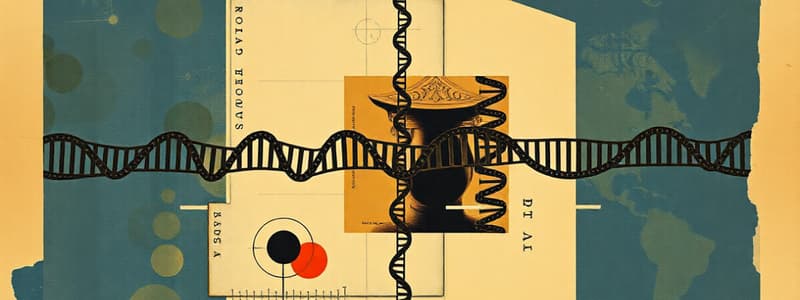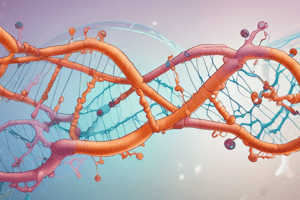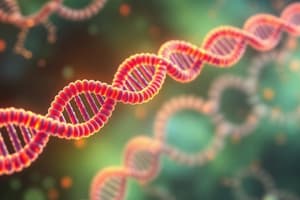Podcast
Questions and Answers
What is the primary role of Ran-GEF in nuclear transport?
What is the primary role of Ran-GEF in nuclear transport?
- To bind to the nuclear export signal (NES)
- To hydrolyze GTP in the cytoplasm
- To stimulate the conversion of Ran-GDP to Ran-GTP (correct)
- To facilitate the binding of exportins to mRNP complexes
What occurs after the exportin1 and Ran-GTP complex enters the cytoplasm?
What occurs after the exportin1 and Ran-GTP complex enters the cytoplasm?
- Exportin1 dissociates from Ran-GDP
- The complex binds to FG domains in the nuclear pore complex
- The cargo protein is transported back to the nucleus
- Ran-GAP stimulates hydrolysis of GTP, releasing the cargo (correct)
What is required for proteins to exit the nucleus?
What is required for proteins to exit the nucleus?
- Binding to Ran-GDP
- Association with mRNP complexes
- A nuclear export signal (NES) (correct)
- A nuclear localization signal (NLS)
Which component is involved in mRNP export in a Ran-independent mechanism?
Which component is involved in mRNP export in a Ran-independent mechanism?
What facilitates diffusion across the nuclear pore complex (NPC) for mRNA?
What facilitates diffusion across the nuclear pore complex (NPC) for mRNA?
What is the primary function of the 5' cap added to nascent mRNA?
What is the primary function of the 5' cap added to nascent mRNA?
Which factor is directly responsible for recognizing the Poly(A) signal during 3’ cleavage and polyadenylation?
Which factor is directly responsible for recognizing the Poly(A) signal during 3’ cleavage and polyadenylation?
What occurs during the first step of mRNA splicing?
What occurs during the first step of mRNA splicing?
What happens during the 'slow phase' of polyadenylation?
What happens during the 'slow phase' of polyadenylation?
Which sequence represents the Poly(A) signal recognized during 3’ cleavage and polyadenylation?
Which sequence represents the Poly(A) signal recognized during 3’ cleavage and polyadenylation?
What is NOT a role of the 5' cap in mRNA processing?
What is NOT a role of the 5' cap in mRNA processing?
During mRNA splicing, what does the OH at the branch point do?
During mRNA splicing, what does the OH at the branch point do?
Which of the following components is NOT involved in the recruitment process during mRNA splicing?
Which of the following components is NOT involved in the recruitment process during mRNA splicing?
What role does U2AF play in mRNA splicing?
What role does U2AF play in mRNA splicing?
What is the primary outcome of alternative splicing in relation to a gene?
What is the primary outcome of alternative splicing in relation to a gene?
Which editing change in the apoB pre-mRNA is specifically noted in intestinal cells?
Which editing change in the apoB pre-mRNA is specifically noted in intestinal cells?
How does the presence of Sxl protein influence splicing in female Drosophila embryos?
How does the presence of Sxl protein influence splicing in female Drosophila embryos?
What is the role of the Nuclear Transport Receptor in the nuclear import process?
What is the role of the Nuclear Transport Receptor in the nuclear import process?
What is the effect of early Sxl protein absence in male Drosophila regarding sex-lethal mRNA splicing?
What is the effect of early Sxl protein absence in male Drosophila regarding sex-lethal mRNA splicing?
What structures within the Nuclear Pore Complex (NPC) form the permeability barrier?
What structures within the Nuclear Pore Complex (NPC) form the permeability barrier?
What prevents the usage of splice sites in female Drosophila during early development?
What prevents the usage of splice sites in female Drosophila during early development?
Which components are involved in the production of female-specific Dsx protein?
Which components are involved in the production of female-specific Dsx protein?
What happens to the Ran-GTP after it aids in the release of the cargo protein in the nucleus?
What happens to the Ran-GTP after it aids in the release of the cargo protein in the nucleus?
Which statement regarding self-splicing introns is true?
Which statement regarding self-splicing introns is true?
Which of the following statements is true regarding the size of molecules that can freely diffuse through the nuclear pore complex?
Which of the following statements is true regarding the size of molecules that can freely diffuse through the nuclear pore complex?
In the nuclear import process, what is the first step taken by free importin when it encounters a cargo protein?
In the nuclear import process, what is the first step taken by free importin when it encounters a cargo protein?
What is the primary function of exonic splicing enhancers (ESEs)?
What is the primary function of exonic splicing enhancers (ESEs)?
What is formed during the transport of molecules through the nuclear pore complex?
What is formed during the transport of molecules through the nuclear pore complex?
What type of domains do proteins need to possess to enter the nucleus?
What type of domains do proteins need to possess to enter the nucleus?
What is the primary sequence recognized as the Poly(A) signal during the cleavage and polyadenylation of pre-mRNA?
What is the primary sequence recognized as the Poly(A) signal during the cleavage and polyadenylation of pre-mRNA?
Which factor is primarily responsible for adding adenine nucleotides to the cleaved 3' end of pre-mRNA?
Which factor is primarily responsible for adding adenine nucleotides to the cleaved 3' end of pre-mRNA?
What is the immediate consequence of the 3' cleavage of pre-mRNA during polyadenylation?
What is the immediate consequence of the 3' cleavage of pre-mRNA during polyadenylation?
What role does the Poly(A) tail serve in mRNA molecules?
What role does the Poly(A) tail serve in mRNA molecules?
What is the role of U1 in the splicing process?
What is the role of U1 in the splicing process?
Which component within the splicing machinery is responsible for binding to exonic splicing enhancers (ESEs)?
Which component within the splicing machinery is responsible for binding to exonic splicing enhancers (ESEs)?
What role does the branch point play in mRNA splicing?
What role does the branch point play in mRNA splicing?
Which statement accurately describes the function of U2AF in splicing?
Which statement accurately describes the function of U2AF in splicing?
How do SR proteins contribute to the splicing process?
How do SR proteins contribute to the splicing process?
What is the main role of the Sxl protein in Drosophila during early development?
What is the main role of the Sxl protein in Drosophila during early development?
Which genes are likely expressed differently between male and female Drosophila?
Which genes are likely expressed differently between male and female Drosophila?
What happens to the sex-lethal gene as Drosophila develop further?
What happens to the sex-lethal gene as Drosophila develop further?
What is the significance of the intronic splicing silencer in the context of Sxl binding?
What is the significance of the intronic splicing silencer in the context of Sxl binding?
Which of the following proteins is involved in the somatic sex determination pathway of Drosophila?
Which of the following proteins is involved in the somatic sex determination pathway of Drosophila?
What effect does early Sxl protein have on exon 3 of the sex-lethal mRNA in female Drosophila?
What effect does early Sxl protein have on exon 3 of the sex-lethal mRNA in female Drosophila?
Which protein's production is directly influenced by the binding of Sxl to ISS in female Drosophila?
Which protein's production is directly influenced by the binding of Sxl to ISS in female Drosophila?
What is the primary consequence of skipping exon 2 during the splicing of sex-lethal mRNA in female Drosophila?
What is the primary consequence of skipping exon 2 during the splicing of sex-lethal mRNA in female Drosophila?
What is the importance of alternative splicing in the sexual differentiation of Drosophila?
What is the importance of alternative splicing in the sexual differentiation of Drosophila?
What occurs when Sxl protein is absent in male Drosophila during sex-lethal mRNA splicing?
What occurs when Sxl protein is absent in male Drosophila during sex-lethal mRNA splicing?
Which protein is directly affected by the splicing of the transformer mRNA in Drosophila males?
Which protein is directly affected by the splicing of the transformer mRNA in Drosophila males?
What is the role of the Sxl protein in female Drosophila?
What is the role of the Sxl protein in female Drosophila?
Which gene’s splicing results in determining the developmental pathway of Drosophila based on the Sxl protein presence?
Which gene’s splicing results in determining the developmental pathway of Drosophila based on the Sxl protein presence?
What is the primary outcome of alternative splicing in the context of Drosophila sex determination?
What is the primary outcome of alternative splicing in the context of Drosophila sex determination?
What characterizes the mRNA differences resulting from RNA editing?
What characterizes the mRNA differences resulting from RNA editing?
Which of the following edits is specifically noted in the editing of apoB pre-mRNA in intestinal cells?
Which of the following edits is specifically noted in the editing of apoB pre-mRNA in intestinal cells?
What distinguishes apoB-48 from apoB-100?
What distinguishes apoB-48 from apoB-100?
In which of the following locations is apoB-100 produced?
In which of the following locations is apoB-100 produced?
What role does the N-terminal domain of apoB-48 play?
What role does the N-terminal domain of apoB-48 play?
What is the primary function of importin in the nuclear import process?
What is the primary function of importin in the nuclear import process?
What triggers the release of cargo protein from the importin complex inside the nucleus?
What triggers the release of cargo protein from the importin complex inside the nucleus?
Which step follows the release of cargo protein from the importin complex in the nuclear import pathway?
Which step follows the release of cargo protein from the importin complex in the nuclear import pathway?
What is the structure through which the importin-cargo complex passes during nuclear transport?
What is the structure through which the importin-cargo complex passes during nuclear transport?
What role does Ran-GDP play after releasing importin from the importin-Ran-GTP complex?
What role does Ran-GDP play after releasing importin from the importin-Ran-GTP complex?
What is the result of the combination of tra, Rbp1, and tra2 proteins in female Drosophila?
What is the result of the combination of tra, Rbp1, and tra2 proteins in female Drosophila?
In male Drosophila, what happens to exon 4 during Dsx protein production?
In male Drosophila, what happens to exon 4 during Dsx protein production?
What molecular process occurs at the 3' end of exon 4 during female Dsx protein production?
What molecular process occurs at the 3' end of exon 4 during female Dsx protein production?
Which of the following accurately describes the outcome of alternative splicing in Drosophila?
Which of the following accurately describes the outcome of alternative splicing in Drosophila?
What is the role of the exotic splicing enhancer in female Drosophila?
What is the role of the exotic splicing enhancer in female Drosophila?
What is the main role of the NXF1 protein in mRNP export?
What is the main role of the NXF1 protein in mRNP export?
Which two components are primarily involved in remolding the mRNP complex for export?
Which two components are primarily involved in remolding the mRNP complex for export?
What is the primary method by which the mRNP complex crosses the nuclear pore complex (NPC)?
What is the primary method by which the mRNP complex crosses the nuclear pore complex (NPC)?
What happens to the mRNA once it reaches the cytoplasm during the export process?
What happens to the mRNA once it reaches the cytoplasm during the export process?
In the context of mRNP export, what is the function of the small NXT1 subunit?
In the context of mRNP export, what is the function of the small NXT1 subunit?
What is the role of the mRNP exporter in the export process of mRNA?
What is the role of the mRNP exporter in the export process of mRNA?
Which components make up the mRNP exporter complex?
Which components make up the mRNP exporter complex?
What occurs during the remodeling phase of the mRNP complex?
What occurs during the remodeling phase of the mRNP complex?
How does the mRNP complex interact with the nuclear pore complex (NPC)?
How does the mRNP complex interact with the nuclear pore complex (NPC)?
What happens to the processed mRNA after it passes through the nuclear pore complex?
What happens to the processed mRNA after it passes through the nuclear pore complex?
Flashcards
mRNA Splicing
mRNA Splicing
The process of removing introns and joining exons in pre-mRNA to form mature mRNA.
Poly(A) signal
Poly(A) signal
A specific DNA sequence (AAUAAA) that signals the location for the addition of the poly(A) tail.
Pre-mRNA
Pre-mRNA
The initial RNA transcript produced by RNA polymerase II before any processing.
Mature mRNA
Mature mRNA
Signup and view all the flashcards
Intron
Intron
Signup and view all the flashcards
Exon
Exon
Signup and view all the flashcards
Self-Splicing Introns
Self-Splicing Introns
Signup and view all the flashcards
Exonic Splicing Enhancers (ESEs)
Exonic Splicing Enhancers (ESEs)
Signup and view all the flashcards
SR Proteins
SR Proteins
Signup and view all the flashcards
Alternative Splicing
Alternative Splicing
Signup and view all the flashcards
Intronic Splicing Silencer
Intronic Splicing Silencer
Signup and view all the flashcards
Sex-lethal (Sxl) Protein
Sex-lethal (Sxl) Protein
Signup and view all the flashcards
Double-sex (Dsx) Protein
Double-sex (Dsx) Protein
Signup and view all the flashcards
RNA Editing
RNA Editing
Signup and view all the flashcards
ApoB-48
ApoB-48
Signup and view all the flashcards
Nuclear Pore Complex (NPC)
Nuclear Pore Complex (NPC)
Signup and view all the flashcards
FG Nucleoporins
FG Nucleoporins
Signup and view all the flashcards
Nuclear Localization Signal (NLS)
Nuclear Localization Signal (NLS)
Signup and view all the flashcards
Importin
Importin
Signup and view all the flashcards
Ran-GTP
Ran-GTP
Signup and view all the flashcards
Ran-GAP
Ran-GAP
Signup and view all the flashcards
Nuclear Export Signal (NES)
Nuclear Export Signal (NES)
Signup and view all the flashcards
Nuclear Transport Receptor
Nuclear Transport Receptor
Signup and view all the flashcards
mRNP Export
mRNP Export
Signup and view all the flashcards
Ran-Independent Mechanism
Ran-Independent Mechanism
Signup and view all the flashcards
Poly A Polymerase (PAP)
Poly A Polymerase (PAP)
Signup and view all the flashcards
Polyadenylation
Polyadenylation
Signup and view all the flashcards
Poly(A) tail
Poly(A) tail
Signup and view all the flashcards
3' end cleavage
3' end cleavage
Signup and view all the flashcards
U2AF
U2AF
Signup and view all the flashcards
Spliceosome
Spliceosome
Signup and view all the flashcards
Cross-exon Recognition Complex
Cross-exon Recognition Complex
Signup and view all the flashcards
Sex Determination Pathway in Drosophila
Sex Determination Pathway in Drosophila
Signup and view all the flashcards
What is alternative splicing?
What is alternative splicing?
Signup and view all the flashcards
What is the role of Sxl protein in Drosophila sex determination?
What is the role of Sxl protein in Drosophila sex determination?
Signup and view all the flashcards
What is the function of Dsx protein in Drosophila?
What is the function of Dsx protein in Drosophila?
Signup and view all the flashcards
What is an intronic splicing silencer?
What is an intronic splicing silencer?
Signup and view all the flashcards
What specific splicing event occurs in female Drosophila to produce functional Sxl protein?
What specific splicing event occurs in female Drosophila to produce functional Sxl protein?
Signup and view all the flashcards
Transformer protein
Transformer protein
Signup and view all the flashcards
A to I or C to U editing
A to I or C to U editing
Signup and view all the flashcards
CAA to UAA Editing in apoB
CAA to UAA Editing in apoB
Signup and view all the flashcards
Nuclear Import
Nuclear Import
Signup and view all the flashcards
tra, Rbp1, and tra2
tra, Rbp1, and tra2
Signup and view all the flashcards
Dsx Protein (doublesex)
Dsx Protein (doublesex)
Signup and view all the flashcards
Exotic Splicing Enhancer
Exotic Splicing Enhancer
Signup and view all the flashcards
Male Dsx Splicing
Male Dsx Splicing
Signup and view all the flashcards
Ran-Independent mRNA Export
Ran-Independent mRNA Export
Signup and view all the flashcards
mRNP Remodeling
mRNP Remodeling
Signup and view all the flashcards
mRNP Complex
mRNP Complex
Signup and view all the flashcards
Study Notes
RNA Processing II & Nucleocytoplasmic Transport
- The lecture is about RNA processing and nucleocytoplasmic transport.
- The date of the lecture is November 20th, 2024.
- The course is BIOL200.
- The presenter is Holly J.
Housekeeping
- There is no lecture on December 4th.
- The instructor will review the course material at the end of the term.
- Students must submit questions by December 3rd at noon.
- All sessions will be recorded.
- Regular tutorials/lectures will resume, but tutorials will be one week behind schedule.
mRNA Processing
- Modifications at the 5' and 3' ends of pre-mRNA are necessary for stability and protection.
- Three main co-transcriptional steps are capping, cleavage and polyadenylation, and splicing.
5' Capping
- Nascent mRNA emerges from the RNA exit channel.
- A methylguanalate cap is added by a capping enzyme.
- This enzyme interacts with RNA polymerase II CTD.
- Capping protects the mRNA and facilitates nuclear export; it leads to recognition by translation initiation factors.
- Relevant proteins include Serine 2 phosphorylation, splicing factors, polyadenylation factors, export factors, and capping enzymes.
- Relevant enzymes include capping enzyme, RNA Pol II, and TFIIH.
3' Cleavage & Polyadenylation
- A poly(A) signal (AAUAAA + G/U) is recognized by cleavage and polyadenylation factors (CPSF, CStF, CFI, and CFII).
- The 3' end of the pre-mRNA is cleaved.
- The 3' end is recognized by poly A polymerase (PAP).
- A slow phase adds 12 A residues to the 3' end of the pre-mRNA.
- A rapid phase adds ~200 A residues using PolyA Binding Protein (PABP).
- Enzymes involved are PAP, CPSF, CStF, CFI, and CFII.
mRNA Splicing
- U1 (intron splice site) and U2 (branch point) interact with mRNA.
- U4, U5, and U6 are recruited.
- U1 and U4 exit the spliceosome.
- Transesterification reactions occur.
- The OH at the branch point attacks the 5' phosphate at the first intron residue to form a lariat.
- The 3' end of the exon attacks the 5' end of the following exon.
- Mature mRNA, snRNAs, and intron are released.
- Relevant enzymes include various PRPF enzymes.
Self-Splicing Introns
- In some cases, introns self-splice without external snRNAs.
- Group II introns are found in mitochondria and chloroplasts and may be the evolutionary predecessors of other introns.
mRNA Splicing Specificity
- The exon cross recognition complex helps with splicing efficiency.
- U2AF helps with splicing efficiency.
- Spliceosome is involved; U1, U2, U2AF65, Branch point, 3' splice site, 5' splice site, , and cross-exon recognition complex.
- SR proteins contain RRM domains and arginine/serine-rich domains; they mediate cooperative binding of U1 to the 5' splice site and U2 to the branch point.
- ESES (exonic splicing enhancers), sequences within the exons, promote splicing.
- Key enzymes involved are U2AF, and various PRPF enzymes.
Alternative Splicing
- The presence of multiple introns allows for multiple variations of a protein from a single gene.
- Results in protein isoforms.
Alternative Splicing Ex: Sexual Differentiation in Drosophila
- Sxl protein is only found in female embryos during early development.
- In males, splicing results in an mRNA containing a stop codon, leading to no functional Sxl protein.
- Later in development, the sex-lethal (Sxl) gene is active in both sexes.
- In males, splicing of tra exon 1 to exon 2 leads to no functional transformer protein.
- In females, exon 3 of sex-lethal mRNA is skipped, leading to functional Sxl protein, binding of Sxl to a splicing silencer.
- Diagrams show the location of exons and introns in the mRNA sequences; these diagrams depict splicing in both males and females, including specific components and proteins involved for each sex-determining pathway stages. Diagrams for tra and dsx pre-mRNAs and mRNAs, detailing the difference in splicing patterns based on the presence/absence of Sxl protein.
RNA Editing
- The mature mRNA sequence sometimes differs from DNA.
- Editing mechanisms include Adenosine to Inosine (A -> I) and Cytosine to Uracil (C -> U).
- Editing of apoB pre-mRNA changes C->U position 6666 in intestinal cells; this leads to a shorter protein isoform, apoB-48, with N-terminal domains that associate with lipids. The diagram shows the location of the changes in the mRNA sequence.
Nucleo-Cytoplasmic Transport
- This section covers transport between the nucleus and cytoplasm.
Nuclear Pore Complex
- Proteins need to enter and exit the nucleus.
- The nuclear pore complex (NPC) is made of nucleoporins, creating a basket and aqueous pore.
- FG nucleoporins have extended disordered regions that form a permeability barrier.
- Small molecules (<60 kDa) can diffuse freely, while larger molecules need active transport.
Nuclear Import
- Proteins with a nuclear localization signal (NLS) require importins to enter the nucleus.
- Importins bind to the NLS on the cargo protein, forming a complex.
- The importin-cargo complex interacts with the FG repeats in the NPC.
- Once in the nucleus, importin interactions with Ran-GTP cause cargo release.
- Importin and Ran-GTP return to the cytoplasm to repeat the cycle.
- Ran proteins, GTP/GDP, Ran-GEF, and Ran-GAP facilitate this process. Specific proteins include: Importins, cargo proteins, Ran-GTP, Ran-GDP, Ran-GEF, and Ran-GAP. Diagrams illustrate the importin/Ran cycle. Ran-GTP.
Nuclear Export
- Proteins with a nuclear export signal (NES) require exportins to leave the nucleus.
- Exportins bind to the NES on the cargo protein, forming a complex.
- The exportin-cargo complex interacts with the FG repeats of the NPC.
- Ran-GAP stimulates hydrolysis of GTP to GDP.
- Cargo is released.
- Exportin and Ran-GDP return to the nucleus. Key components include Ran-GTP/GDP, Ran-GEF and Ran-GAP.
mRNP Export
- mRNPs are exported from the nucleus using a Ran-independent mechanism.
- mRNP exporter proteins (e.g., NXF1 and NXT1) bind to RNA that has associated pre-mRNA proteins; mRNA binding is cooperative.
- The exporter cooperatively binds to RNA and forms a domain that interacts with FG repeats of the NPC; thus, the proteins diffuse through the NPC.
- Key components include mRNP exporter complex (NXF1 with NXT1 subunit), ribosome, capping site, and PolyA tail. Diagrams illustrate the components involved in the mRNP export process; arrows show the direction of movement for the proteins involved in the export process. mRNPs associate with proteins and other RNAs in the nucleus. Large proteins (e.g. NXF1) likely play a role in export.
Studying That Suits You
Use AI to generate personalized quizzes and flashcards to suit your learning preferences.




